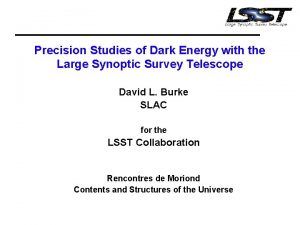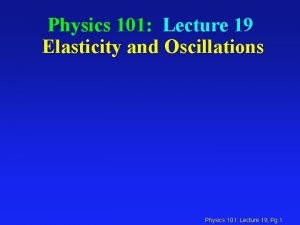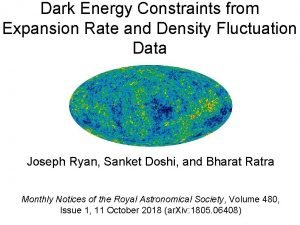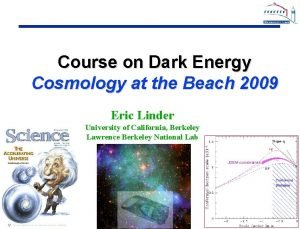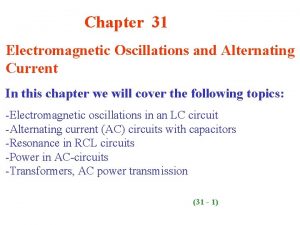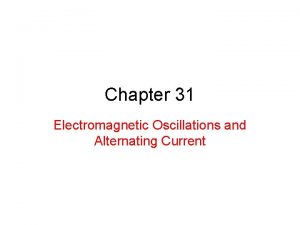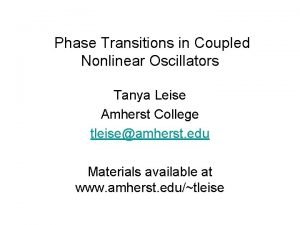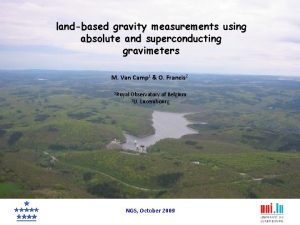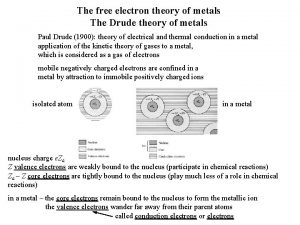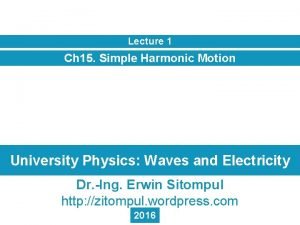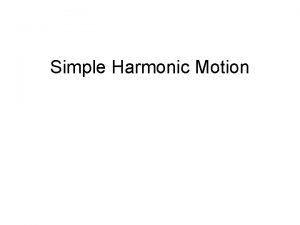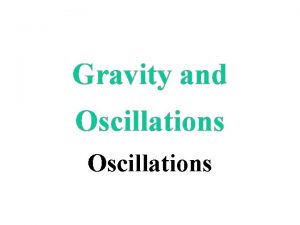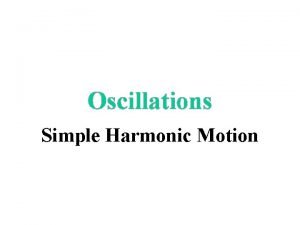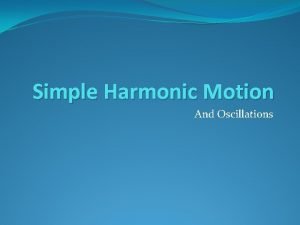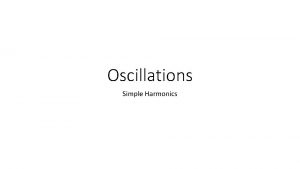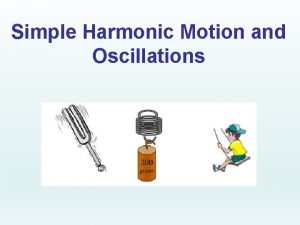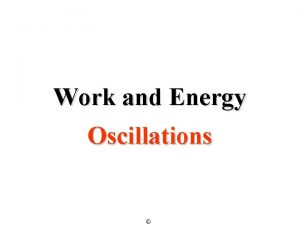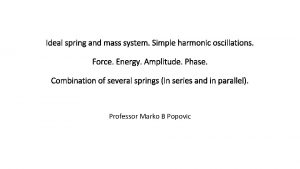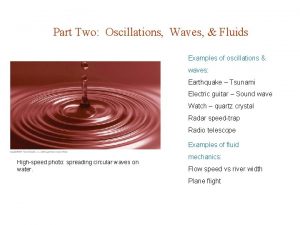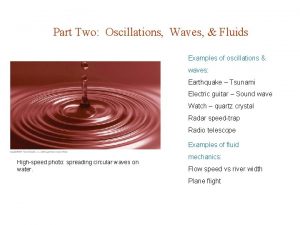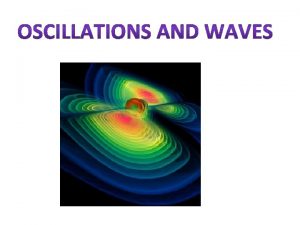Lecture 2 Oscillations Oscillations of a Spring Simple






















- Slides: 22

Lecture 2: Oscillations • Oscillations of a Spring • Simple Harmonic Motion • Energy in the Simple Harmonic Oscillator • The Simple Pendulum 1 Copyright © 2009 Pearson Education, Inc.

14 -1 Oscillations of a Spring If an object vibrates or oscillates back and forth over the same path, each cycle taking the same amount of time, the motion is called periodic. The mass and spring system is a useful model for a periodic system. 2 Copyright © 2009 Pearson Education, Inc.

14 -1 Oscillations of a Spring We assume that the surface is frictionless. There is a point where the spring is neither stretched nor compressed; this is the equilibrium position. We measure displacement from that point (x = 0 on the previous figure). The force exerted by the spring depends on the displacement: 3 Copyright © 2009 Pearson Education, Inc.

14 -1 Oscillations of a Spring • The minus sign on the force indicates that it is a restoring force—it is directed to restore the mass to its equilibrium position. • k is the spring constant. • The force is not constant, so the acceleration is not constant either. 4 Copyright © 2009 Pearson Education, Inc.

14 -1 Oscillations of a Spring • Displacement is measured from the equilibrium point. • Amplitude is the maximum displacement. • A cycle is a full to-and-fro motion. • Period is the time required to complete one cycle. • Frequency is the number of cycles completed per second. 5 Copyright © 2009 Pearson Education, Inc.

14 -1 Oscillations of a Spring If the spring is hung vertically, the only change is in the equilibrium position, which is at the point where the spring force equals the gravitational force. 6 Copyright © 2009 Pearson Education, Inc.

14 -2 Simple Harmonic Motion Any vibrating system where the restoring force is proportional to the negative of the displacement is in simple harmonic motion (SHM), and is often called a simple harmonic oscillator (SHO). Substituting F = kx into Newton’s second law gives the equation of motion: with solutions of the form: 7 Copyright © 2009 Pearson Education, Inc.

14 -2 Simple Harmonic Motion Because then 8 Copyright © 2009 Pearson Education, Inc.

14 -2 Simple Harmonic Motion Example 14 -2: Car springs again. Determine the period and frequency of a car whose mass is 1400 kg and whose shock absorbers have a spring constant of 6. 5 x 104 N/m after hitting a bump. Assume the shock absorbers are poor, so the car really oscillates up and down. 9 Copyright © 2009 Pearson Education, Inc.

14 -2 Simple Harmonic Motion Example 14 -5: Spring calculations. A spring stretches 0. 150 m when a 0. 300 -kg mass is gently attached to it. The spring is then set up horizontally with the 0. 300 -kg mass resting on a frictionless table. The mass is pushed so that the spring is compressed 0. 100 m from the equilibrium point, and released from rest. Determine: (a) the spring stiffness constant k and angular frequency ω; (b) the amplitude of the horizontal oscillation A; (c) the magnitude of the maximum velocity vmax; (d) the magnitude of the maximum acceleration amax of the mass; (e) the period T and frequency f; (f) the displacement x as a function of time; and (g) the velocity at t = 0. 150 s. 10 Copyright © 2009 Pearson Education, Inc.

14 -3 Energy in the Simple Harmonic Oscillator We already know that the potential energy of a spring is given by: The total mechanical energy is then: The total mechanical energy will be conserved, as we are assuming the system is frictionless. 11 Copyright © 2009 Pearson Education, Inc.

14 -3 Energy in the Simple Harmonic Oscillator If the mass is at the limits of its motion, the energy is all potential. If the mass is at the equilibrium point, the energy is all kinetic. We know what the potential energy is at the turning points: 12 Copyright © 2009 Pearson Education, Inc.

14 -3 Energy in the Simple Harmonic Oscillator The total energy is, therefore, And we can write: This can be solved for the velocity as a function of position: where 13 Copyright © 2009 Pearson Education, Inc.

14 -3 Energy in the Simple Harmonic Oscillator This graph shows the potential energy function of a spring. The total energy is constant. 14 Copyright © 2009 Pearson Education, Inc.

14 -3 Energy in the Simple Harmonic Oscillator Conceptual Example 14 -8: Doubling the amplitude. Suppose this spring is stretched twice as far (to x = 2 A). What happens to (a) the energy of the system, (b) the maximum velocity of the oscillating mass, (c) the maximum acceleration of the mass? 15 Copyright © 2009 Pearson Education, Inc.

14 -5 The Simple Pendulum A simple pendulum consists of a mass at the end of a lightweight cord. We assume that the cord does not stretch, and that its mass is negligible. 16 Copyright © 2009 Pearson Education, Inc.

14 -5 The Simple Pendulum In order to be in SHM, the restoring force must be proportional to the negative of the displacement. Here we have: which is proportional to sin θ and not to θ itself. However, if the angle is small, sin θ ≈ θ. 17 Copyright © 2009 Pearson Education, Inc.

14 -5 The Simple Pendulum Therefore, for small angles, we have: where The period and frequency are: 18 Copyright © 2009 Pearson Education, Inc.

14 -5 The Simple Pendulum So, as long as the cord can be considered massless and the amplitude is small, the period does not depend on the mass. 19 Copyright © 2009 Pearson Education, Inc.

14 -5 The Simple Pendulum Example 14 -9: Measuring g. A geologist uses a simple pendulum that has a length of 37. 10 cm and a frequency of 0. 8190 Hz at a particular location on the Earth. What is the acceleration of gravity at this location? 20 Copyright © 2009 Pearson Education, Inc.

Summary of Chapter 14 • For SHM, the restoring force is proportional to the displacement. • The period is the time required for one cycle, and the frequency is the number of cycles per second. • Period for a mass on a spring: • SHM is sinusoidal. • During SHM, the total energy is continually changing from kinetic to potential and back. 21 Copyright © 2009 Pearson Education, Inc.

Summary of Chapter 14 • A simple pendulum approximates SHM if its amplitude is not large. Its period in that case is: 22 Copyright © 2009 Pearson Education, Inc.
 01:640:244 lecture notes - lecture 15: plat, idah, farad
01:640:244 lecture notes - lecture 15: plat, idah, farad Kim ki duk summer fall winter spring
Kim ki duk summer fall winter spring Summer autumn winter
Summer autumn winter Baryon acoustic oscillations
Baryon acoustic oscillations Elasticity and oscillations
Elasticity and oscillations Sustained translatory technique
Sustained translatory technique The expanding faster than should
The expanding faster than should Baryon acoustic oscillations
Baryon acoustic oscillations Baryon acoustic oscillations
Baryon acoustic oscillations Electromagnetic oscillations and alternating current
Electromagnetic oscillations and alternating current Electromagnetic oscillations and alternating current
Electromagnetic oscillations and alternating current Baryonic acoustic oscillations
Baryonic acoustic oscillations Coupled oscillations
Coupled oscillations Slow oscillations
Slow oscillations Velocity resonance
Velocity resonance Electrical conductivity formula
Electrical conductivity formula Plasma oscillations
Plasma oscillations Lotka-volterra predator-prey model
Lotka-volterra predator-prey model Slidetodoc
Slidetodoc Simple harmonic motion lecture
Simple harmonic motion lecture Spring constant
Spring constant Simple present simple past simple future exercises
Simple present simple past simple future exercises Present simple past simple future simple
Present simple past simple future simple



